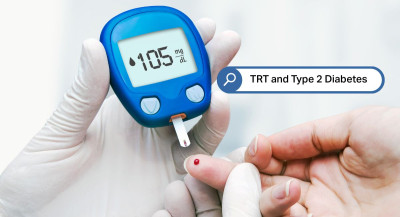TRT For Younger Men: Early‑Onset Low T In Your 30s (What You Really Need To Know)


More men in their 30s across Canada are asking an important question: Why do I feel this tired, unmotivated, and off my game?

While testosterone decline is often considered a concern for older men, early-onset low testosterone is real, and it can show up far earlier than most expect.
Symptoms like persistent fatigue, low libido, poor focus, and decreased muscle mass are no longer just “part of getting older” when you’re still in your prime.
That’s why testosterone replacement therapy (TRT) in Canada is gaining attention among younger men looking for real answers and lasting energy. This article explores what’s normal, what’s not, and when it’s worth getting tested.
Topics covered in this article:
- What Is Early‑Onset Low Testosterone?
- Common Causes in Your 30s
- Signs and Symptoms of Low T in Your 30s
- Diagnosis and Testing for Younger Men
- Treatment Options and Trade‑Offs
- What to Expect with TRT Early On
- Lifestyle Changes: The First Line of Defence
- Who Should Be Cautious
- UPGUYS Support for Younger Men Exploring TRT
- FAQs – Young Men’s Concerns
- Conclusion: Taking Charge Early: Your Options, Your Timing
- References
What Is Early‑Onset Low Testosterone?
Early‑onset low testosterone, sometimes called early hypogonadism, refers to testosterone deficiency that shows up during a man’s 30s (or younger than the typical age‑related decline), not as part of normal aging. It differs from late‑onset low T in its causes, speed of onset, and impact. Some key characteristics:

- Causes are often secondary or primary hypogonadism (e.g., pituitary issues, testicular injury, genetics), not just wear and tear from aging.
- Symptoms may include low libido, unexplained fatigue, mood changes, muscle loss, and sometimes fertility issues. Because the drop is steep relative to expected testosterone levels in one’s 30s, symptoms can feel more intense or earlier.
- Diagnostic thresholds are similar (low total testosterone plus symptoms), but doctors may put more emphasis on ruling out reversible causes (stress, sleep, medications, lifestyle).
- Treatment decisions in early‑onset low T often involve more consideration of fertility, long‑term risk, and whether non‑TRT methods (like lifestyle, hCG, clomiphene) may be used first or in conjunction.
Early‑onset low T is not just “feeling tired” or “losing energy” from life stresses — it is a diagnosable hormonal condition that may significantly impact wellbeing.
Common Causes in Your 30s
When men in their 30s develop symptoms of low testosterone, several potential causes beyond “normal aging” should be considered. These causes often differ from those seen in older men. Many of them are modifiable or treatable if identified early. Here are the leading contributors:
- Obesity and metabolic dysfunction: Excess body fat, especially visceral (abdominal) fat, increases conversion of testosterone into estrogen through the enzyme aromatase. Obesity also lowers sex hormone binding globulin (SHBG), reducing the amount of bioavailable testosterone.
- Sleep apnea and poor sleep quality: Obstructive sleep apnea (OSA) is strongly associated with lower testosterone. Repeated nighttime oxygen dips and fragmented sleep impair the hormonal pulses needed to maintain healthy testosterone levels.
- Chronic stress and lifestyle factors: High stress, poor sleep habits, shift work, and persistent fatigue raise cortisol levels that can suppress testosterone production.
- Medications, alcohol, and substance use: Some medications (e.g. opioids, some antidepressants, steroids) and excess alcohol use can impair the hypothalamic-pituitary-gonadal axis, reducing testosterone levels.
- Genetic or testicular issues/illness: Conditions such as Klinefelter syndrome, undiagnosed testicular injury, mumps orchitis, pituitary disorders or prior trauma/illness of the testes may lead to primary hypogonadism.
In many cases, it’s a mix of more than one factor. Understanding the cause helps guide how to address it — whether through lifestyle change, medical therapy, or careful use of TRT if appropriate.
Signs and Symptoms of Low T in Your 30s
For men in their 30s, low testosterone symptoms are often subtle and easy to miss. They can overlap with the effects of stress, poor sleep, or overwork, making diagnosis more complex without proper testing. However, persistent or worsening symptoms may signal early-onset hypogonadism.
Common physical, mental, and sexual symptoms include:
- Low energy and chronic fatigue: Feeling constantly drained, even with adequate sleep.
- Decreased muscle mass and strength: Difficulty maintaining or gaining muscle despite consistent exercise.
- Increased body fat: Especially around the midsection, even with no major lifestyle changes.
- Low libido: Reduced sexual desire, less frequent spontaneous erections.
- Erectile dysfunction: Trouble achieving or maintaining an erection, not always responsive to ED meds.
- Mood changes: Irritability, sadness, anxiety, or loss of motivation that doesn’t improve with time.
- Poor concentration and brain fog: Difficulty focusing or remembering things.
- Sleep disturbances: Trouble falling or staying asleep, sometimes linked with nighttime hot flashes or restlessness.
Since these symptoms can also be caused by factors like stress, depression, or thyroid issues, blood testing is essential to confirm whether testosterone is truly the issue.
Diagnosis and Testing for Younger Men
Diagnosing low testosterone in your 30s requires more than just noticing symptoms — it depends on accurate, properly timed blood tests and a full clinical evaluation.
Here’s what’s typically involved:
- Timing matters: Testosterone should be tested early in the morning (usually before 10 a.m.), when levels are naturally highest.
- What to test: Most doctors begin with a total testosterone test. If results are borderline or symptoms are strong, they may also check free testosterone, which measures the biologically active hormone not bound to proteins.
- Repeat testing: Since testosterone levels can fluctuate, two separate tests are often needed to confirm a diagnosis. One abnormal result is not enough.
- Fertility considerations: For men in their 30s, fertility is a key factor. TRT can reduce or shut down sperm production, so your doctor may suggest a semen analysis or sperm banking before starting treatment.
In Canada, testosterone replacement therapy (TRT) is only recommended when consistent lab evidence and clinical symptoms align — especially in younger men. A thorough consultation with a licensed provider is crucial to rule out other causes and ensure the right treatment path.

Treatment Options and Trade‑Offs
For younger men diagnosed with low testosterone, treatment options come with benefits, risks, and important decisions — especially around fertility and long-term health.
TRT (Testosterone Replacement Therapy):
- Pros: Can improve energy, libido, mood, focus, and body composition.
- Risks: May suppress natural testosterone production and significantly reduce or eliminate sperm count.
- Monitoring: Requires regular follow-ups to check hormone levels, red blood cell count, and overall response.
Fertility is a major consideration in your 30s. If you want children now or in the future, TRT may not be the best first-line option unless paired with medications that protect fertility.
Alternative or adjunct options include:
- hCG (human chorionic gonadotropin): Helps stimulate natural testosterone and preserve sperm production. Often used with or instead of TRT.
- Clomiphene citrate: A non-steroidal option that prompts your body to make more testosterone on its own, with less impact on fertility.
- Lifestyle changes: Weight loss, improved sleep, resistance training, stress management, and reduced alcohol intake can all raise testosterone levels naturally.
In Canada, treatment for early-onset low testosterone should be tailored by a licensed doctor who understands your health goals — whether that’s restoring vitality, protecting fertility, or both.
What to Expect with TRT Early On
Starting testosterone replacement therapy (TRT) in your 30s can bring noticeable changes, but it’s not instant — and it comes with responsibilities.

Response Time:
- Most men begin to feel improvements in energy, mood, and libido within 3 to 6 weeks.
- Body composition and strength gains often take a few months.
- Full benefits may take up to 6 months or longer, depending on the individual.
Possible Early Side Effects:
- Mild acne or oily skin
- Fluctuations in mood
- Increased red blood cell count (monitored via blood tests)
- Temporary changes in sleep patterns
Monitoring and Follow-Ups:
- Your doctor will schedule regular blood tests to check testosterone levels, hematocrit, and other markers.
- Dosage may be adjusted based on how your body responds.
- Ongoing evaluation ensures safe, long-term use — especially in younger men where fertility or hormonal balance may still be shifting.
For younger patients in Canada using testosterone replacement therapy (TRT), consistent monitoring is not optional. It’s what separates safe, doctor-led treatment from risky self-medication.
Lifestyle Changes: The First Line of Defence
Before jumping into testosterone replacement therapy (TRT), especially for men in their 30s, it’s worth asking: have you done everything you can naturally?
Low testosterone at a younger age is often tied to lifestyle. That means real, measurable improvements are possible without medical treatment.
Here are the top areas to focus on:
- Sleep: Getting 7 to 9 hours of quality sleep is critical. Poor sleep, especially from conditions like sleep apnea, directly lowers testosterone levels.
- Diet: Nutrient deficiencies, too much processed food, and low protein intake can all interfere with hormone production. A balanced diet with healthy fats (like omega-3s) supports testosterone.
- Weight loss: Excess body fat, especially around the abdomen, contributes to lower testosterone and higher estrogen. Even a 5 to 10% weight loss can make a difference.
- Exercise: Resistance training (like lifting weights) and high-intensity interval training (HIIT) are proven to naturally boost testosterone.
- Stress management: Chronic stress raises cortisol, which can suppress testosterone. Tools like mindfulness, therapy, and downtime help reset that balance.
For some men, these changes alone are enough to restore energy, mood, and libido. Even for those who move forward with TRT, lifestyle still plays a major role in supporting results and long-term health.
Who Should Be Cautious
While testosterone replacement therapy (TRT) in Canada can offer life-changing benefits, it’s not the right fit for everyone — especially younger men with specific goals or health concerns. It’s important to weigh the risks before starting treatment.
You should be cautious about TRT if you:
- Plan to have children: TRT can suppress sperm production by shutting down the body’s natural testosterone and sperm-making processes. For men looking to become fathers, alternative options like hCG or clomiphene citrate may be safer.
- Have certain pre-existing health conditions: TRT is not typically recommended for men with:
- Uncontrolled heart disease
- Untreated sleep apnea
- High red blood cell counts (polycythemia)
- Prostate cancer or elevated PSA levels
In these cases, TRT could pose additional risks or worsen existing conditions. Always consult a doctor experienced in hormone therapy to assess your full health profile before starting any treatment.
UPGUYS Support for Younger Men Exploring TRT
At UPGUYS, we understand that low testosterone can affect men well before their 40s. That’s why we offer a judgment-free, clinically sound approach to testosterone replacement therapy (TRT) in Canada — including support for younger men.

Here’s how we help:
- Easy access to testing: Our licensed Canadian doctors can provide lab requisitions to assess total and free testosterone levels accurately.
- Transparent care: No consultation or shipping fees. You’ll know what to expect from the start.
- Individualized treatment plans: If TRT is appropriate, we tailor your dosage and schedule based on your specific symptoms and health goals.
- Ongoing monitoring: We don’t just prescribe and disappear. We follow up regularly to ensure safety, effectiveness, and long-term results.
- Fertility-aware options: If fertility is a concern, our medical team can discuss your goals and guide you through potential alternatives or modifications to traditional TRT.
UPGUYS makes it easier for younger men in Canada to get the right answers, the right treatment, and the right support, all from home.
FAQs – Young Men’s Concerns
Yes. While low testosterone is more common with age, many men in their 30s experience symptoms due to factors like obesity, chronic stress, poor sleep, or past medical issues. Early-onset low T is real and diagnosable.
TRT can reduce or even stop sperm production temporarily. If fertility is a priority, talk to your doctor about alternatives like hCG or clomiphene that may preserve sperm while addressing low T symptoms.
Symptoms like fatigue, low libido, or mood changes can stem from multiple causes. That’s why blood tests, lifestyle reviews, and medical evaluations are essential before starting any treatment.
TRT can be safe when monitored properly by a licensed provider. However, younger men should weigh benefits against long-term commitments, fertility concerns, and the need for consistent follow-up care.
Absolutely. Weight loss, regular strength training, better sleep, and reducing alcohol or stress can all help raise testosterone naturally. These lifestyle changes are often the first recommendation before starting medication.
Conclusion: Taking Charge Early: Your Options, Your Timing
Low testosterone in your 30s can feel frustrating, especially when symptoms like fatigue, low libido, or poor motivation start to interfere with your life. But getting informed and taking action early puts you in control. With the right testing, expert medical advice, and a clear plan, you don’t have to guess what’s going on with your body.
For men in Canada, testosterone replacement therapy (TRT) is one of several tools available—but it's not the only option. Whether you move forward with treatment, explore fertility-preserving alternatives, or start with lifestyle changes, the key is tailoring your approach to your goals.
Early action leads to better long-term outcomes. Your 30s don’t have to mean low energy forever. The right support makes all the difference.
References
UPGUYS has strict sourcing guidelines to ensure our content is accurate and current. We rely on peer-reviewed studies, academic research institutions, and medical associations. We strive to use primary sources and refrain from using tertiary references.- Male Hypogonadism, NIH,
https://www.ncbi.nlm.nih.gov/books/NBK532933/ - Male hypogonadism, Mayo Clinic,
https://www.mayoclinic.org/diseases-conditions/male-hypogonadism/symptoms-causes/syc-20354881 - Approach to the Patient: Low Testosterone Concentrations in Men With Obesity, JCEM,
https://academic.oup.com/jcem/article/110/9/e3125/8058933 - Obstructive Sleep Apnea and Testosterone Deficiency, PubMed,
https://pubmed.ncbi.nlm.nih.gov/29774669/
This article is written for informational purposes only and does not constitute medical advice. The information provided in the articles cannot and should not replace advice from a healthcare professional. Talk to your healthcare provider about any physical or mental health concerns or the risks and benefits of any treatment or medication.





